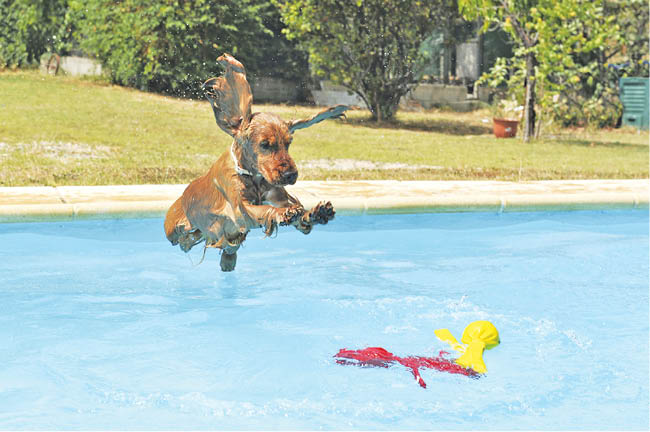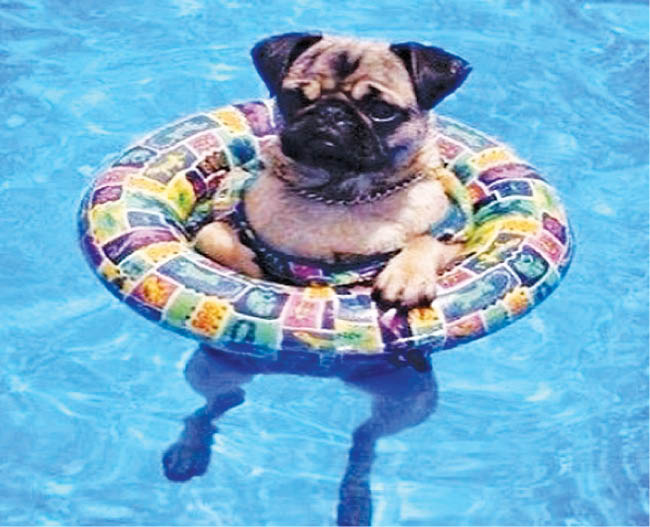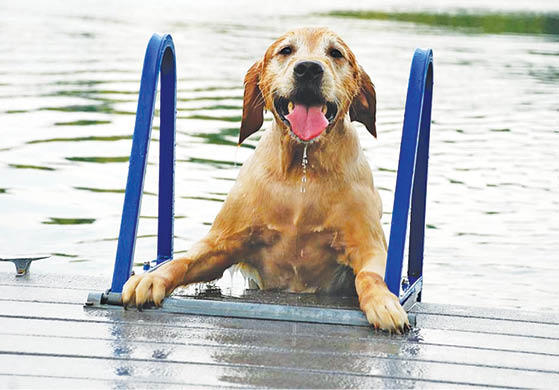On a blistering hot day, a cool inviting swimming pool can make for a refreshing refuge from the heat. For most canines, the pool rules as summer’s favourite activity. After all, it is the only place where doggy paddle is allowed, belly flops encouraged and swimsuits are optional! Here are a few tips you should keep in mind before allowing your pooch to take the plunge.
 Give Your Dog Time To Perfect His Stroke
Give Your Dog Time To Perfect His Stroke
Although most dogs love to swim, don’t assume they can swim naturally – it takes time for a dog to get his ‘doggy paddle technique’ perfect. NEVER throw a dog into a pool – it can disorient the animal, make him panic and thrash about in the water, and cause him to fear water bodies in future.
Give Your Dog A Break
Even if your dog wants to keep playing in the water, as a responsible owner you should realise that at some point the dog will need to take a break. When a dog is exhausted it is difficult for him to keep his head above the water; if he is allowed to keep swimming he could well tire and drown. Even excellent swimmers lose their ability over time as they age and become weaker. So watch your dog carefully and get him out of the water when he shows signs of tiring.
It’s Not Always Cool Around A Pool
Heat and sunlight are more intense around a pool. Even though the dog maybe swimming in water, he still can get overheated. So watch for signs of overheating such as laboured breathing, glazed look in the eyes and fatigue. In addition, pool decks can heat up and burn the pads of a dog’s feet. Avoid leaving your dog on such surfaces for too long or equip him with a set of doggy booties.
 Qualms About Chlorine
Qualms About Chlorine
The chlorine in a swimming pool can play havoc with your dog’s health. Make sure your dog has access to clean drinking water all the time so that he doesn’t need to drink the chlorinated water from the pool – it can make him sick. In the same vein, you should also be aware that chlorinated water might irritate your dog’s eyes. When your dog has finished playing in the pool, hose your dog down with fresh water to get the chlorine out of his eyes and coat.
Ear Fear
Dogs who love to swim are more susceptible to ear infections than landlubbers. Commercial ear cleaners change the pH of the inner ear and act as drying agents. Ask your veterinarian to recommend one for your water-loving dog.
Avert A Drowning Disaster
Pool safety issues for pets are almost synonymous with those for children and they go far beyond just careful supervision. To avert a drowning disaster, make sure that your dog has no access to a pool without supervision. It takes only a few minutes of distraction for a dog to fly out the door and into a pool. Make sure there are enough safety measures in place to guard against an animal accidentally or intentionally wandering into the pool when you are not around. If he falls in, he may not be able to climb out by himself. Senior dogs are more prone to slipping and falling into a pool; so be very careful.
 Don’t Let The Crocs Bite
Don’t Let The Crocs Bite
If you are swimming your dog in a lake or pond, be aware of the dangers that lurk inside. Make sure that your local government or municipality has approved of the area for swimming. Many lakes and ponds can be home to other creatures like crocodiles, poisonous fish and sharp rocks.
The body of water may also contain harmful bacteria or algae, especially in stagnant pools of water. Some algae, particularly the blue-green kind, are very dangerous and if ingested by your dog, can cause serious illness and sometimes even death. Don’t allow your pet near stagnant water or algae, and make sure he doesn’t drink from these water sources.
- ઝેડટીએફઆઈ સર્કલ ઓફ કાઇન્ડનેસ – સમુદાય સેવાની 15 વર્ષની ઉજવણી કરે છે - 2 November2024
- પુના પારસી પંચાયત 2024 ચૂંટણીના પરિણામો - 2 November2024
- બીજેપીસી શાળાએ પ્રતિષ્ઠિત પુરસ્કારો મેળવ્યા - 2 November2024
